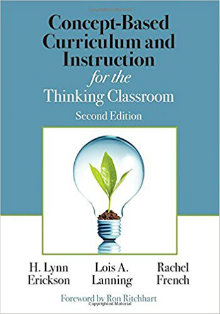Concept Learning in the Thinking Classroom
Concept-Based Curriculum and Instruction for the Thinking Classroom 2nd Edition
By H. Lynn Erickson, Lois A. Lanning and Rachel French
(Corwin, 2017 – Learn more)

Why do the students not remember the material longer than the last test? Why are we still teaching as if everyone will function as a factory worker? The world is so different now and will be rapidly changing in the future. Our students need the skills to compete. The 21st century needs people who can deal with the complexities of living, working and thinking in an increasingly complex world.

For students to think in complex ways, there has to be a working relationship between lower level thinking and conceptual level thinking. In essence, we need to know the facts to be able to do the higher levels of thinking.
The authors’ method uses the processes of critical, creative and reflective thinking from Ron Ritchart‘s work, with conceptual thinking added to the list by the authors.
Chapter 2 is about “The Structures of Knowledge and Process.” They are explained and illustrated with diagrams and examples from different subject areas. These are the foundational starting points for designing curriculum.
From here, a teacher would unpack the concepts and generalizations from the content and then go on to develop what the students will be required to know, understand, and do. The goal of this plan is to create learners who are capable of complex thinking and also able to transfer the concepts to other situations and problems.
How to build concept-based instruction
After beginning with the structure of effective design, in chapter 3 the authors go on to share the steps, actually showing us how to design concept-based instructional units. They take us from creating the unit title and identifying the conceptual lens and unit strands to developing the guiding questions and learning experiences to formulating the assessments.
There is also a comparison of a topic-based unit versus a concept-based unit. This is really helpful because the difference is clearly seen in the example.
Using inquiry learning in concept-based lessons is the theme of chapter 4. It illustrates how concept-based instruction develops a deeper understanding of unit concepts while furthering the method of inquiry that is needed to obtain them.
The authors discuss the difference between inductive and deductive instruction and also show us how structured versus guided inquiry differ. In addition, they lead us by pointing out the two most common difficulties that come into play while making this change to a “concept and generalization” emphasis rather than just a “fact and skill” emphasis.
Supporting us as we learn
The last chapter deals with “The Developing Concept-Based Teacher and Self- Assessments.” The authors give us four rubrics to help with our own self-assessment. Examples of several myths that have developed around this topic of instruction are also given and are explained and refuted.
Even though chapter 5 is the last chapter, the book goes on to a plethora of resources. There are lesson templates, examples of lessons, checklists, and even most frequently asked questions to guide us in continuing our challenging but rewarding journey into concept-based teaching.
Joanne Bell is a middle school teacher at St. Joseph Elementary School in Cottleville, Missouri. She currently teaches social studies to sixth and seventh graders, but has spent most of her 34 years in the elementary grades.



































